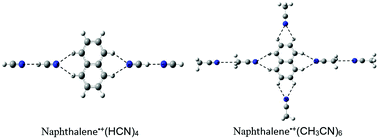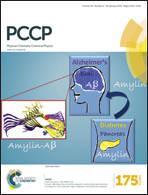Unconventional CHδ+⋯N hydrogen bonding interactions in the stepwise solvation of the naphthalene radical cation by hydrogen cyanide and acetonitrile molecules†
Abstract
Equilibrium thermochemical measurements using the mass-selected ion mobility (MSIM) technique have been utilized to investigate the binding energies and entropy changes of the stepwise association of hydrogen cyanide (HCN) and acetonitrile (CH3CN) molecules with the naphthalene radical cation (C10H8˙+) in the gas phase forming the C10H8˙+(HCN)n and C10H8˙+(CH3CN)n clusters with n = 1–3 and 1–5, respectively. The lowest energy structures of the C10H8˙+(HCN)n and C10H8˙+(CH3CN)n clusters for n = 1–2 have been calculated using the M062X and ω97XD methods within the 6-311+G** basis set, and for n = 1–6 using the B3LYP method within the 6-311++G** basis set. In both systems, the initial interaction occurs through unconventional CHδ+⋯N ionic hydrogen bonds between the hydrogen atoms of the naphthalene cation and the lone pair of electrons on the N atom of the HCN or the CH3CN molecule. The binding energy of CH3CN to the naphthalene cation (11 kcal mol−1) is larger than that of HCN (7 kcal mol−1) due to a stronger ion–dipole interaction resulting from the large dipole moment of CH3CN (3.9 D). On the other hand, HCN can form both unconventional hydrogen bonds with the hydrogen atoms of the naphthalene cation (CHδ+⋯NCH), and conventional linear hydrogen bonding chains involving HCN⋯HCN interactions among the associated HCN molecules. HCN molecules tend to form “externally solvated” structures with the naphthalene cation where the naphthalene ion is hydrogen bonded to the exterior of an HCN⋯HCN chain. For the C10H8˙+(CH3CN)n clusters, “internally solvated” structures are favored where the acetonitrile molecules are directly interacting with the naphthalene cation through CHδ+⋯N unconventional ionic hydrogen bonds. In both the C10H8˙+(HCN)n and C10H8˙+(CH3CN)n clusters, the sequential binding energy decreases stepwise to about 6–7 kcal mol−1 by three HCN or CH3CN molecules, approaching the macroscopic enthalpy of vaporization of liquid HCN (6.0 kcal mol−1).


 Please wait while we load your content...
Please wait while we load your content...